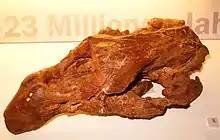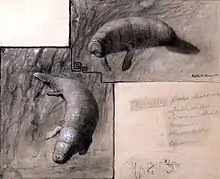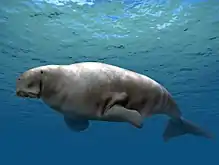Eosiren
Eosiren is an extinct genus of sea cow that lived during the Late Eocene (later Priabonian) to Early Oligocene (Rupelian).[1] Several fossils have been found in Egypt. It seems like the species E. abeli were contemporaneous with Protosiren and Eotheroides.[1] like them, Eosiren closely resembled modern sirenians. It differs from them by having somewhat larger innominates and possess thigh bones.[1]
| Eosiren Temporal range: Late Eocene-Oligocene | |
|---|---|
 | |
| Skull of E. libyca . | |
| Scientific classification | |
| Kingdom: | |
| Phylum: | |
| Class: | |
| Order: | |
| Family: | |
| Subfamily: | †Halitheriinae |
| Genus: | Eosiren Andrews, 1902 |
| Species | |
| |

Drawing of skeleton.

E. libyca and an extant manatee by Charles R. Knight, 1907

Size of Eosiren (purple) compared to other Eocene sirenians and a human.
Eosiren was first described by vertebrage paleontologist Charles William Andrews in 1902, who distinguished it from the genus Halitherium due to differences in the teeth and mandible.[2] Later that year, Science published a summary of his findings in a collection on advances in zoopaleontology.[3]
References
- Zalmout I.S. & Gingerich P.D. (2012), “Late Eocene sea cows (Mammalia, Sirenia) from Wadi al Hitan in the western desert of Fayum, Egypt”, University of Michigan Papers on Paleontology No. 37
- Andrews, C. W. (1902). "II.—Preliminary Note on some Recently Discovered Extinct Vertebrates from Egypt. (Part III.)". Geological Magazine. 9 (7): 291–295. doi:10.1017/S0016756800181178. S2CID 248538038.
- Osborn, H. F. (31 October 1902). "Recent Zoopaleontology". Science. 16 (409): 749–752. doi:10.1126/science.16.410.749. JSTOR 1628916. PMID 17776565. Retrieved 27 January 2021.
This article is issued from Wikipedia. The text is licensed under Creative Commons - Attribution - Sharealike. Additional terms may apply for the media files.
